Simulation and Experimental Study on the Precision Molding of Irregular Vehicle Glass Components
Abstract
:1. Introduction
2. Numerical Simulation and Analysis
2.1. Numerical Modeling
- (1)
- Geometric model
- (2)
- Material models
- (3)
- Boundary conditions
| Stress Relaxation | Structural Relaxation | ||
|---|---|---|---|
| Shear Modulus (MPa) | Relaxation Time (s) | Weight Coefficient | Relaxation Time (s) |
| 12,566 | 0.0689 | 0.108 | 3.0 |
| 0.443 | 0.671 | ||
| 12,615 | 0.0065 | 0.166 | 0.247 |
| 0.161 | 0.091 | ||
| 4582 | 0.0001 | 0.046 | 0.033 |
| 0.077 | 0.008 | ||
2.2. Result Analysis
2.3. Scheme Design
3. Influence of Molding Parameters on Quality and Energy Consumption
3.1. Residual Stress
3.2. Dimension Deviation
3.3. Energy Consumption
4. Optimization of Molding Process
4.1. Regression Model
4.2. Multi-Objective Optimization
- (1)
- ;
- (2)
- Iteration number = 500;
- (3)
- Population size = 100;
- (4)
- Fitness function value deviation = 1 × 10−100;
- (5)
- Crossover probability = 0.5;
- (6)
- Mutation probability = 0.0005.
4.3. Experimental Validation
5. Conclusions
- (1)
- The simulation model of large glass component molding was established, the temperature variation of the glass blank and graphite mold during the heating stage was analyzed, and the quality characteristics of the molded component were precisely predicted. The results indicate that the stress is predominantly concentrated in the bending deformation position of the molded component, with the maximum dimension deviation occurring at the central position.
- (2)
- Among the various factors, the molding temperature, molding pressure, and cooling rate have the most significant impact on the molding process of glass components. Under the combination of a molding temperature of 580 °C, molding pressure of 25 MPa, and cooling rate of 1.25 °C/s, the residual stress remains consistently low. Similarly, under the combination of a molding temperature of 570 °C, molding pressure of 30 MPa, and cooling rate of 1.25 °C/s, the dimension deviation is kept to a minimum. Furthermore, with a molding temperature of 550 °C, molding pressure of 30 MPa, and cooling rate of 1 °C/s, lower energy consumption in the production of glass components can be obtained.
- (3)
- The combination of a heating rate of 1.95 °C/s, holding time of 158 s, molding temperature of 570 °C, molding pressure of 34 MPa, and cooling rate of 1.15 °C/s was determined as the cooperative balance scheme for quality characteristics and energy consumption by NSGA-II there-objective optimization. The optimized prediction closely aligned with both simulation and experimental results, with a maximum error not exceeding 20%, well within the acceptable range.
Author Contributions
Funding
Data Availability Statement
Conflicts of Interest
References
- Ming, W.; Cao, C.; Zhang, G.; Zhang, H.; Zhang, F.; Jiang, Z.; Yuan, J. Review: Application of Convolutional Neural Network in Defect Detection of 3C Products. IEEE Access 2021, 9, 135657–135674. [Google Scholar] [CrossRef]
- Angle, M.A.; Blair, G.E.; Maier, C.C. Method for Molding Glass Lens. U.S. Patent US3833347A, 3 September 1974. [Google Scholar]
- Cha, D.H.; Park, H.S.; Hwang, Y.; Kim, J.-H.; Kim, H.-J. Experimental Study of Glass Molding Process and Transcription Characteristics of Mold Surface in Molding of Aspheric Glass Lenses. Opt. Rev. 2011, 18, 241–246. [Google Scholar] [CrossRef]
- Nieto, D.; Flores-Arias, M.T.; O’Connor, G.M.; Gomez-Reino, C. Laser Direct-Write Technique for Fabricating Microlens Arrays on Soda-Lime Glass with a Nd:YVO_4 Laser. Appl. Opt. 2010, 49, 4979. [Google Scholar] [CrossRef]
- Yi, A.Y.; Jain, A. Compression Molding of Aspherical Glass Lenses-A Combined Experimental and Numerical Analysis. J. Am. Ceram. Soc. 2005, 88, 579–586. [Google Scholar] [CrossRef]
- Ming, W.; Chen, Z.; Du, J.; Zhang, Z.; Zhang, G.; He, W.; Ma, J.; Shen, F. A Comprehensive Review of Theory and Technology of Glass Molding Process. Int. J. Adv. Manuf. Technol. 2020, 107, 2671–2706. [Google Scholar] [CrossRef]
- Ming, W.; Zhang, S.; Liu, X.; Liu, K.; Yuan, J.; Xie, Z.; Sun, P.; Guo, X. Survey of Mura Defect Detection in Liquid Crystal Displays Based on Machine Vision. Crystals 2021, 11, 1444. [Google Scholar] [CrossRef]
- Ming, W.; Xie, Z.; Jiang, Z.; Chen, Y.; Zhang, G.; Xu, Y.; He, W. Progress in Optical Adhesive and Lamination Process of Touch Screen in 3C Products. J. Soc. Inf. Disp. 2022, 30, 851–876. [Google Scholar] [CrossRef]
- Chen, Y.; Zhang, S.; Hu, S.; Zhao, Y.; Zhang, G.; Cao, Y.; Ming, W. Study of Heat Transfer Strategy of Metal Heating/Conduction Plates for Energy Efficiency of Large-Sized Automotive Glass Molding Process. Metals 2023, 13, 1218. [Google Scholar] [CrossRef]
- Zhang, Z.; Ming, W.; Zhang, Y.; Yin, L.; Xue, T.; Yu, H.; Chen, Z.; Liao, D.; Zhang, G. Analyzing Sustainable Performance on High-Precision Molding Process of 3D Ultra-Thin Glass for Smart Phone. J. Clean. Prod. 2020, 255, 120196. [Google Scholar] [CrossRef]
- Yan, J.; Zhou, T.; Masuda, J.; Kuriyagawa, T. Modeling High-Temperature Glass Molding Process by Coupling Heat Transfer and Viscous Deformation Analysis. Precis. Eng. 2009, 33, 150–159. [Google Scholar] [CrossRef]
- Tao, B.; Yuan, Y. FEM Simulation of the Effect of Coefficient of Thermal Expansion and Heat Capacity on Prediction of Residual Stresses of Compression Molded Glass Lenses. IOP Conf. Ser. Mater. Sci. Eng. 2017, 269, 012050. [Google Scholar] [CrossRef]
- Sarhadi, A.; Hattel, J.H.; Hansen, H.N. Evaluation of the Viscoelastic Behaviour and Glass/Mould Interface Friction Coefficient in the Wafer Based Precision Glass Moulding. J. Mater. Process. Technol. 2014, 214, 1427–1435. [Google Scholar] [CrossRef]
- Schott North America Inc. TIE-40 Optical Glass for Precision Molding; Schott North America Inc.: Rye Brook, NY, USA, 2006. [Google Scholar]
- Fotheringham, U.; Baltes, A.; Fischer, P.; Höhn, P.; Jedamzik, R.; Schenk, C.; Stolz, C.; Westenberger, G. Refractive Index Drop Observed After Precision Molding of Optical Elements: A Quantitative Understanding Based on the Tool–Narayanaswamy–Moynihan Model. J. Am. Ceram. Soc. 2008, 91, 780–783. [Google Scholar] [CrossRef]
- Su, L.; Wang, F.; He, P.; Dambon, O.; Klocke, F.; Yi, A.Y. An Integrated Solution for Mold Shape Modification in Precision Glass Molding to Compensate Refractive Index Change and Geometric Deviation. Opt. Lasers Eng. 2014, 53, 98–103. [Google Scholar] [CrossRef]
- Balajee, A. Computational Modeling of Precision Molding of Aspheric Glass Optics. Ph.D. Thesis, Clemson University, Clemson, SC, USA, 2008. [Google Scholar]
- Dambon, O.; Wang, F.; Klocke, F.; Pongs, G.; Bresseler, B.; Chen, Y.; Yi, A.Y. Efficient Mold Manufacturing for Precision Glass Molding. J. Vac. Sci. Technol. B Microelectron. Nanometer Struct. Process. Meas. Phenom. 2009, 27, 1445–1449. [Google Scholar] [CrossRef]
- Chen, Y.; Hu, S.; Li, A.; Cao, Y.; Zhao, Y.; Ming, W. Parameters Optimization of Electrical Discharge Machining Process Using Swarm Intelligence: A Review. Metals 2023, 13, 839. [Google Scholar] [CrossRef]
- Ming, W.; Guo, X.; Zhang, G.; Hu, S.; Liu, Z.; Xie, Z.; Zhang, S.; Duan, L. Optimization of Process Parameters and Performance for Machining Inconel 718 in Renewable Dielectrics. Alex. Eng. J. 2023, 79, 164–179. [Google Scholar] [CrossRef]
- Ming, W.; Guo, X.; Xu, Y.; Zhang, G.; Jiang, Z.; Li, Y.; Li, X. Progress in Non-Traditional Machining of Amorphous Alloys. Ceram. Int. 2023, 49, 1585–1604. [Google Scholar] [CrossRef]
- Jafarian, F.; Amirabadi, H.; Sadri, J. Experimental Measurement and Optimization of Tensile Residual Stress in Turning Process of Inconel718 Superalloy. Measurement 2015, 63, 1–10. [Google Scholar] [CrossRef]
- Saini, S.; Ahuja, I.S.; Sharma, V.S. Modelling the Effects of Cutting Parameters on Residual Stresses in Hard Turning of AISI H11 Tool Steel. Int. J. Adv. Manuf. Technol. 2013, 65, 667–678. [Google Scholar] [CrossRef]
- Zhang, Q.; Mahfouf, M.; Yates, J.R.; Pinna, C.; Panoutsos, G.; Boumaiza, S.; Greene, R.J.; De Leon, L. Modeling and Optimal Design of Machining-Induced Residual Stresses in Aluminium Alloys Using a Fast Hierarchical Multiobjective Optimization Algorithm. Mater. Manuf. Process. 2011, 26, 508–520. [Google Scholar] [CrossRef]
- Chen, Z.; Qian, L.; Cui, R.; Liu, J.; Zhang, Q. Machining-Induced Residual Stress Analysis and Multi-Objective Optimization for Milling Process of Mg–Li Alloy. Measurement 2022, 204, 112127. [Google Scholar] [CrossRef]
- Li, C.; Li, X.; Wu, Y.; Zhang, F.; Huang, H. Deformation Mechanism and Force Modelling of the Grinding of YAG Single Crystals. Int. J. Mach. Tools Manuf. 2019, 143, 23–37. [Google Scholar] [CrossRef]
- He, W.; Chen, Z.; Ming, W.; Du, J.; Cao, Y.; Ma, J.; Wei, A. Multi-Objective Optimization of Glass Multi-Station Bending Machining for Smartphone Curved Screen. J. Braz. Soc. Mech. Sci. Eng. 2019, 41, 476. [Google Scholar] [CrossRef]
- He, W.; Li, Z.; Liu, T.; Liu, Z.; Guo, X.; Du, J.; Li, X.; Sun, P.; Ming, W. Research Progress and Application of Deep Learning in Remaining Useful Life, State of Health and Battery Thermal Management of Lithium Batteries. J. Energy Storage 2023, 70, 107868. [Google Scholar] [CrossRef]
- Ming, W.; Sun, P.; Zhang, Z.; Qiu, W.; Du, J.; Li, X.; Zhang, Y.; Zhang, G.; Liu, K.; Wang, Y.; et al. A Systematic Review of Machine Learning Methods Applied to Fuel Cells in Performance Evaluation, Durability Prediction, and Application Monitoring. Int. J. Hydrogen Energy 2023, 48, 5197–5228. [Google Scholar] [CrossRef]
- Ming, W.; Jia, H.; Huang, H.; Zhang, G.; Liu, K.; Lu, Y.; Cao, C. Study on Mechanism of Glass Molding Process for Fingerprint Lock Glass Plates. Crystals 2021, 11, 394. [Google Scholar] [CrossRef]
- Park, J.; Chang, S.; Lee, D.; Lee, H.; Kang, B.; Kim, J. Two-Step Glass Molding Process for Forming Glass Edges with Obtuse Angles for Mobile Displays. Micromachines 2022, 13, 1032. [Google Scholar] [CrossRef]
- Gurganus, D.; Novak, S.; Symmons, A.; Davies, M. Process Evaluation and Optimization for Freeform Precision Glass Molding. In Optical Manufacturing and Testing XIII; Online Only; Rascher, R., Kim, D.W., Eds.; SPIE: Bellingham, DC, USA, 2020; p. 31. [Google Scholar]
- Liu, X.; Xue, C. Optimization of Molding Process Parameters of Chalcogenide Glass Based on Finite Element Simulation. Laser Optoelectron. Prog. 2018, 55, 082203. [Google Scholar] [CrossRef]
- Zhou, T.; Yan, J.; Kuriyagawa, T. Evaluating the Viscoelastic Properties of Glass above Transition Temperature for Numerical Modeling of Lens Molding Process. Int. Soc. Opt. Eng. 2007, 6624, 662403. [Google Scholar] [CrossRef]
- Zhou, T.; Yan, J.; Masuda, J.; Kuriyagawa, T. Investigation on the Viscoelasticity of Optical Glass in Ultraprecision Lens Molding Process. J. Mater. Process. Technol. 2009, 209, 4484–4489. [Google Scholar] [CrossRef]
- Hong, Z.; Luo, T.; Jiang, S.; Liang, R. Fiber-Fed 3D Printing of Germanate Glass Optics. Photonics 2023, 10, 378. [Google Scholar] [CrossRef]
- Nielsen, J.H.; Olesen, J.F.; Poulsen, P.N.; Stang, H. Finite Element Implementation of a Glass Tempering Model in Three Dimensions. Comput. Struct. 2010, 88, 963–972. [Google Scholar] [CrossRef]
- Ming, W.; Jiang, Z.; Chen, Z.; He, W.; Li, X. Modelling and Analysis of Energy Consumption in Glass Molding Process for Smartphone Covers Using Different Heating Strategies. Int. J. Adv. Manuf. Technol. 2023, 124, 1491–1512. [Google Scholar] [CrossRef]
- Zhang, Z.; Qiu, W.; Zhang, G.; Liu, D.; Wang, P. Progress in Applications of Shockwave Induced by Short Pulsed Laser on Surface Processing. Opt. Laser Technol. 2023, 157, 108760. [Google Scholar] [CrossRef]
- Wang, P.; Zhang, Z.; Hao, B.; Wei, S.; Huang, Y.; Zhang, G. Investigation on Heat Transfer and Ablation Mechanism of CFRP by Different Laser Scanning Directions. Compos. Part B Eng. 2023, 262, 110827. [Google Scholar] [CrossRef]
- Du, W.; Yang, L.; Wang, H.; Gong, X.; Zhang, L.; Li, C.; Ji, L. LN-MRSCAE: A Novel Deep Learning Based Denoising Method for Mechanical Vibration Signals. J. Vib. Control 2023, 107754632311517. [Google Scholar] [CrossRef]
- Du, W.; Hu, P.; Wang, H.; Gong, X.; Wang, S. Fault Diagnosis of Rotating Machinery Based on 1D–2D Joint Convolution Neural Network. IEEE Trans. Ind. Electron. 2023, 70, 5277–5285. [Google Scholar] [CrossRef]
- Deb, K.; Jain, H. An Evolutionary Many-Objective Optimization Algorithm Using Reference-Point-Based Nondominated Sorting Approach, Part I: Solving Problems With Box Constraints. IEEE Trans. Evol. Computat. 2014, 18, 577–601. [Google Scholar] [CrossRef]
- Tian, M.; Gong, X.; Yin, L.; Li, H.; Ming, W.; Zhang, Z.; Chen, J. Multi-Objective Optimization of Injection Molding Process Parameters in Two Stages for Multiple Quality Characteristics and Energy Efficiency Using Taguchi Method and NSGA-II. Int. J. Adv. Manuf. Technol. 2017, 89, 241–254. [Google Scholar] [CrossRef]
- Yang, W.; Zhang, Z.; Ming, W.; Yin, L.; Zhang, G. Study on Shape Deviation and Crack of Ultra-Thin Glass Molding Process for Curved Surface. Ceram. Int. 2022, 48, 6767–6779. [Google Scholar] [CrossRef]

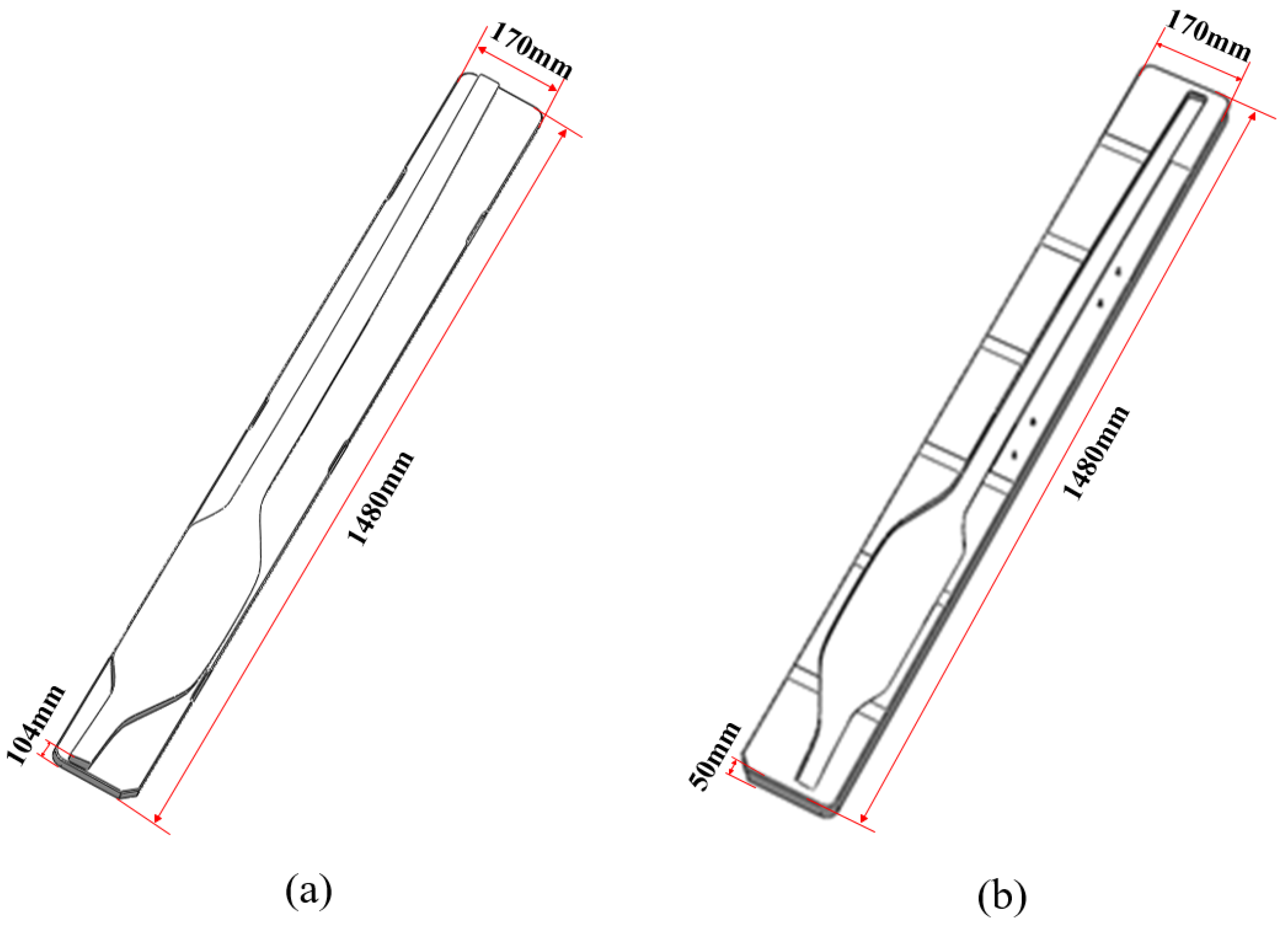
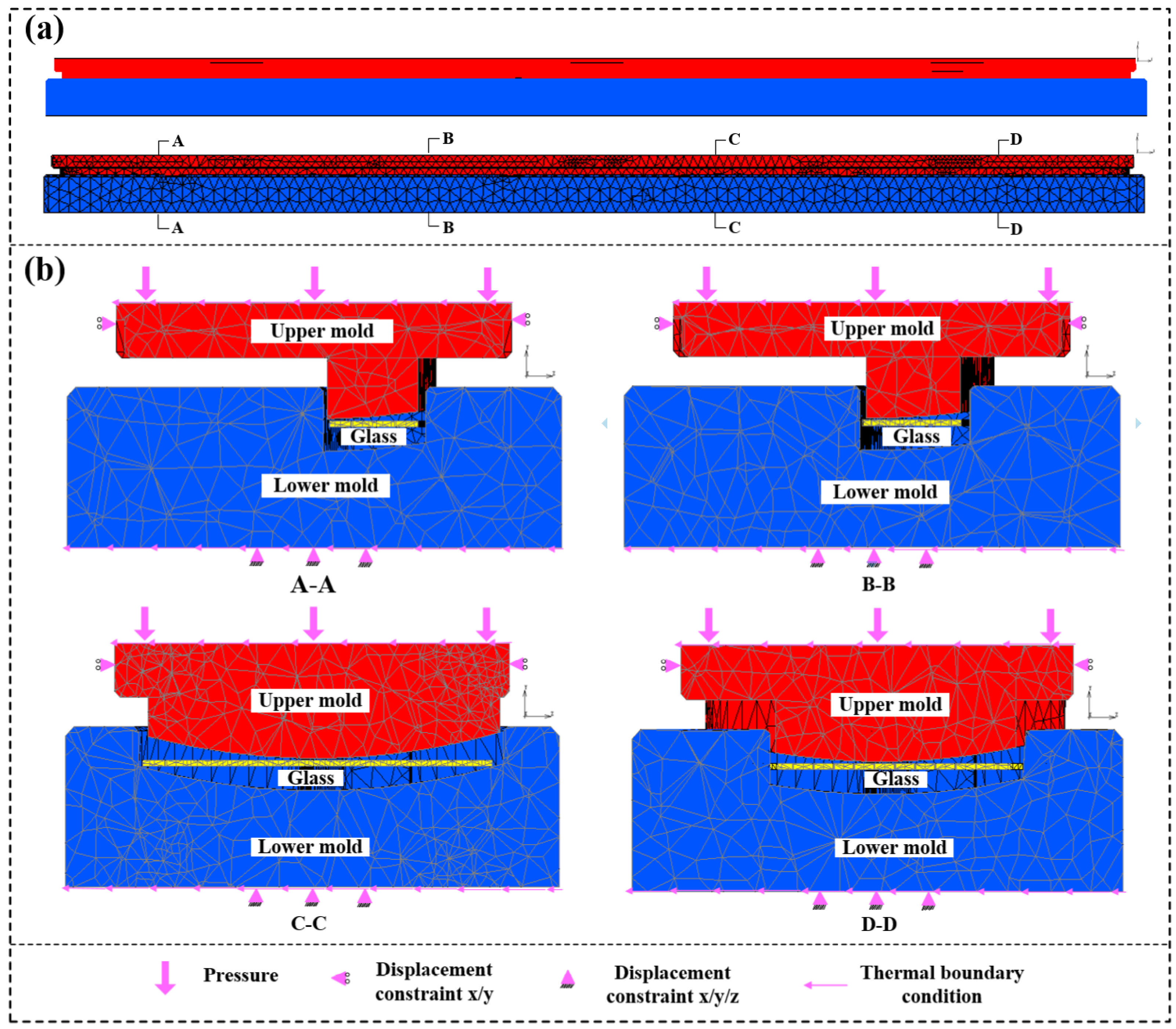

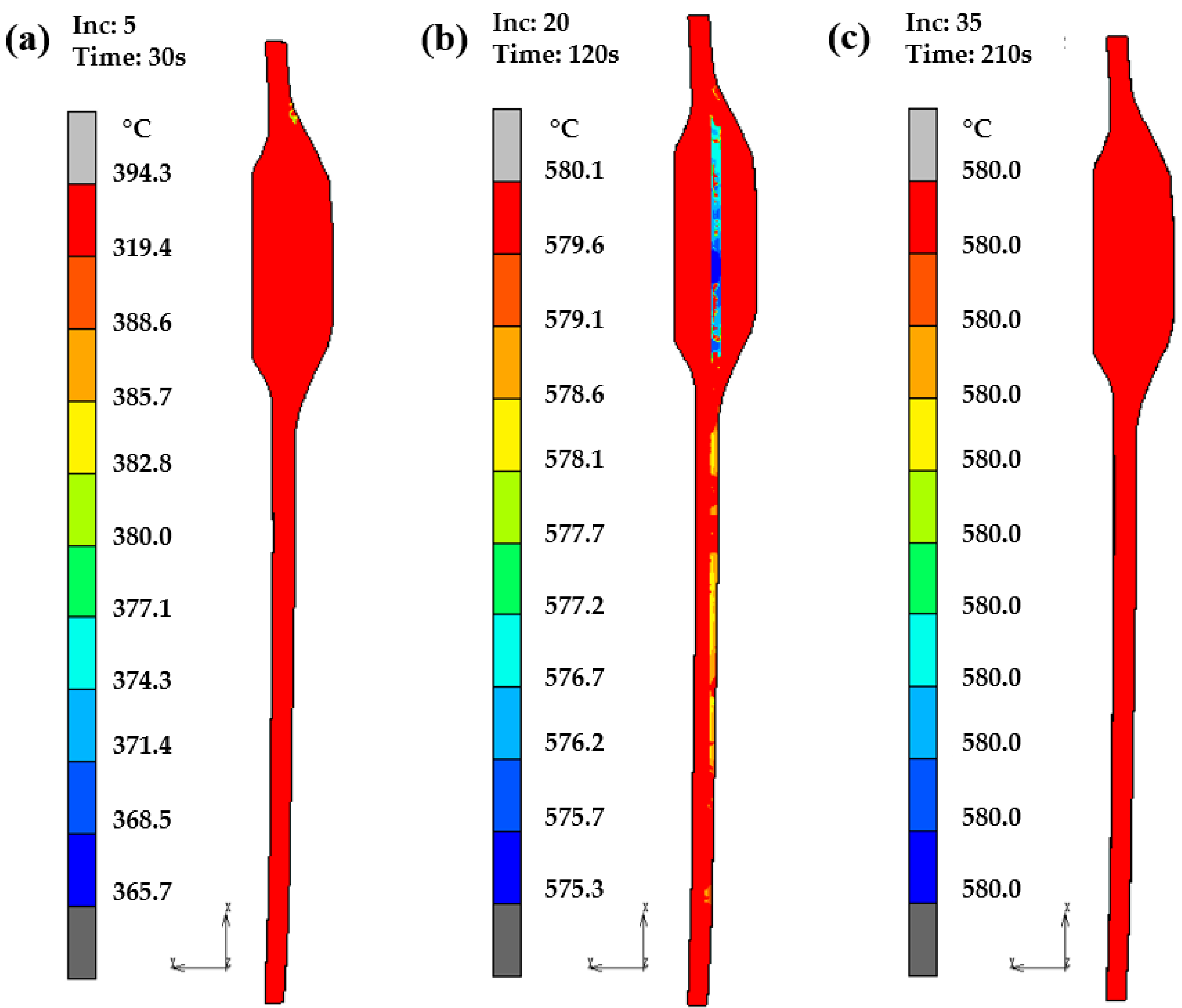
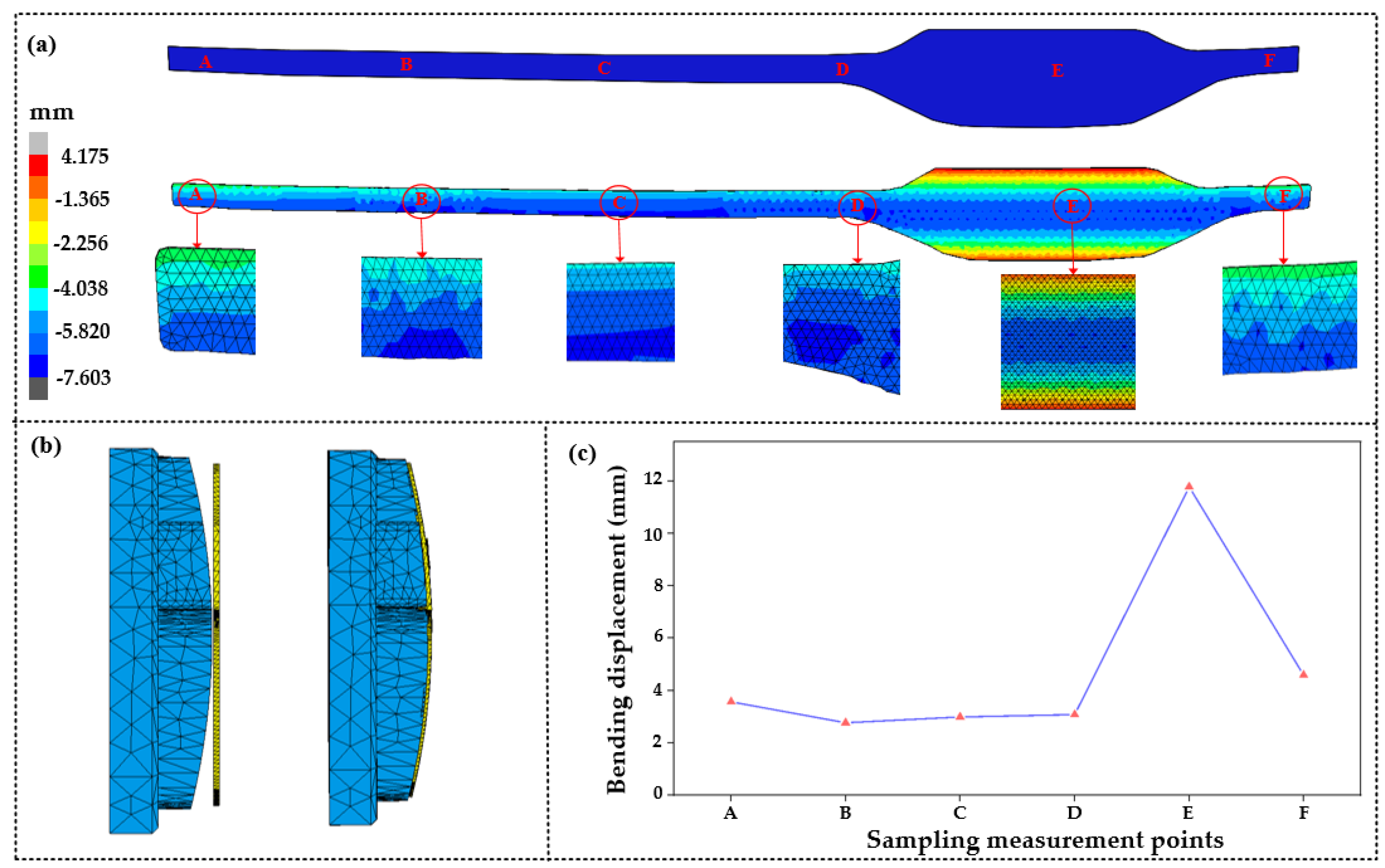
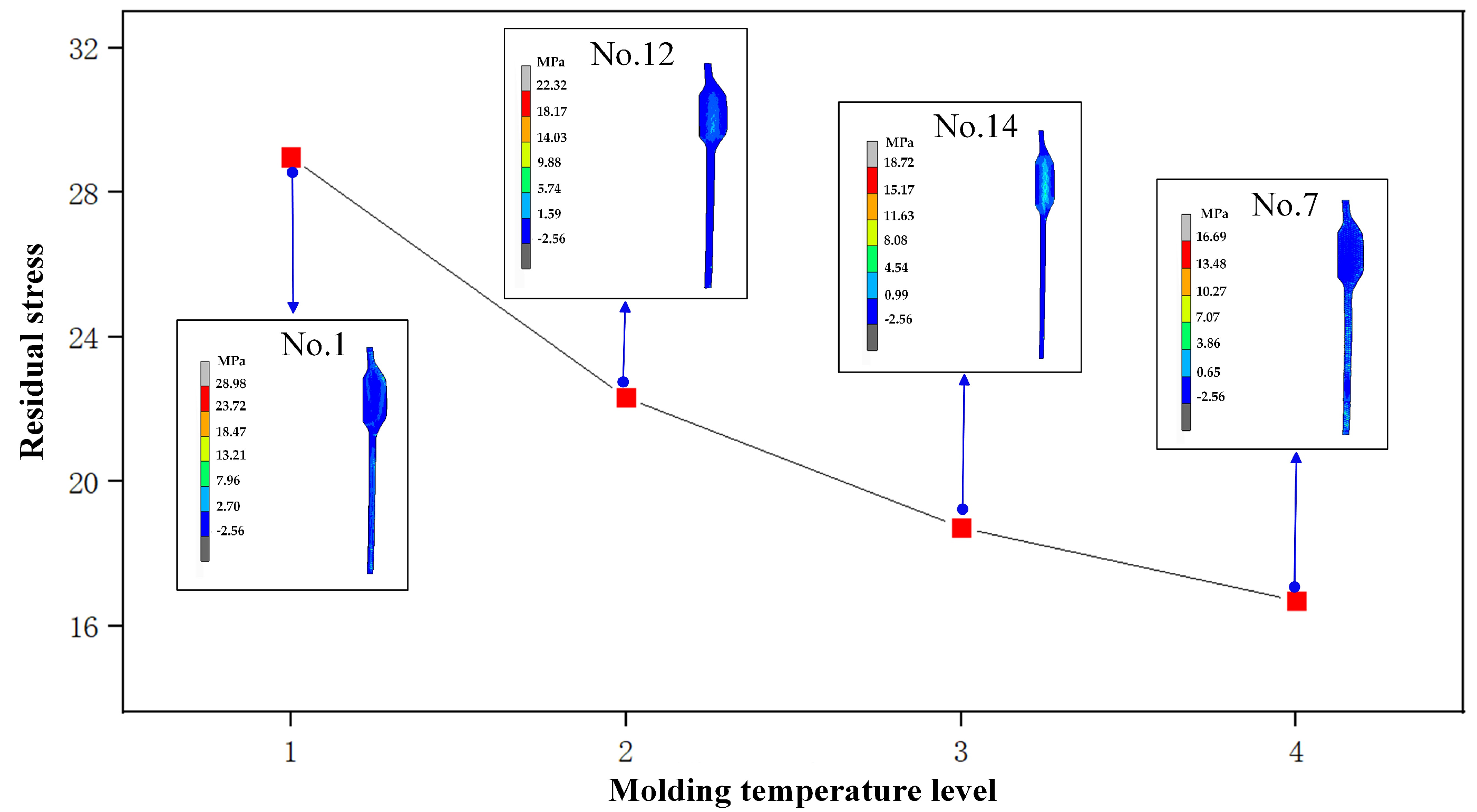
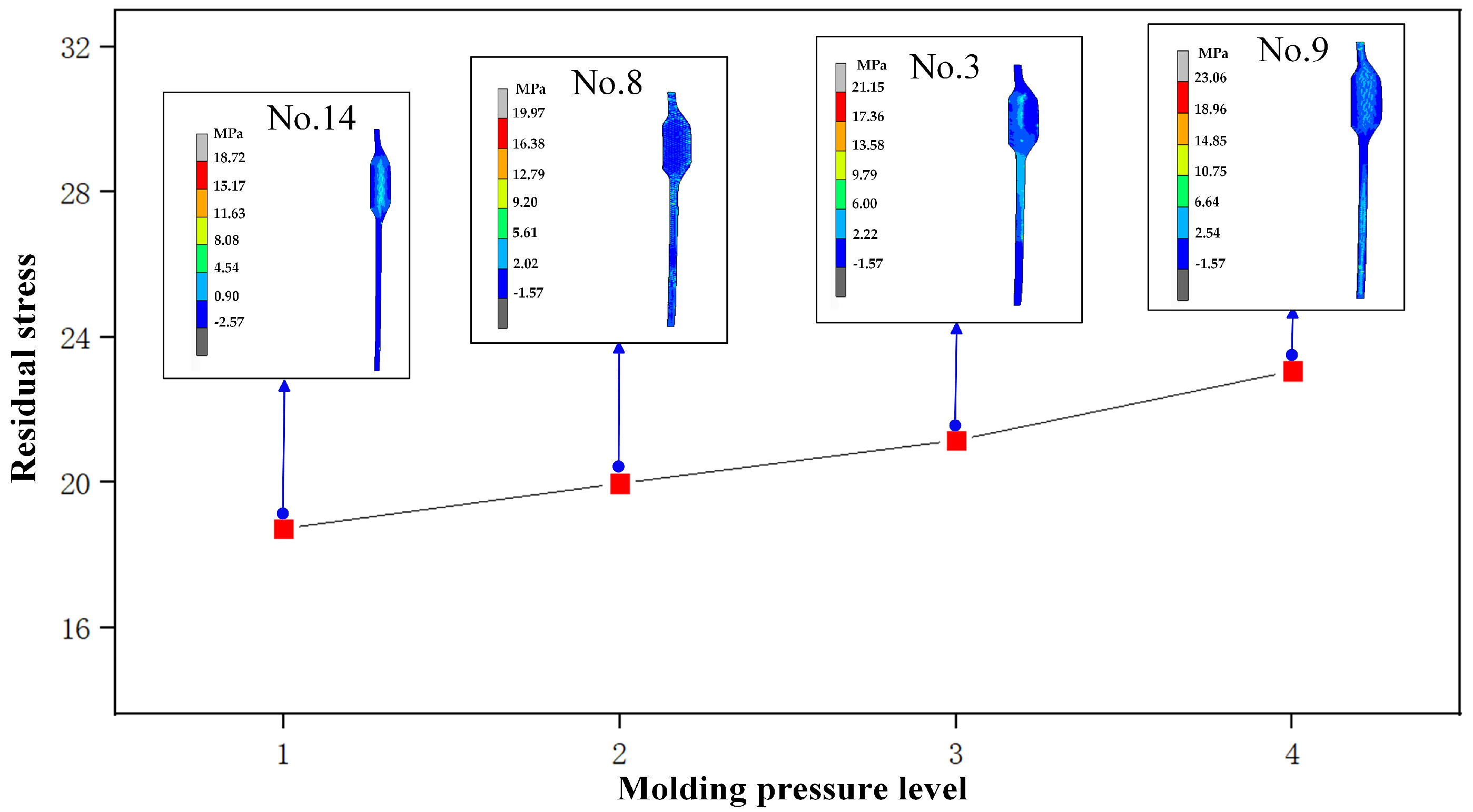

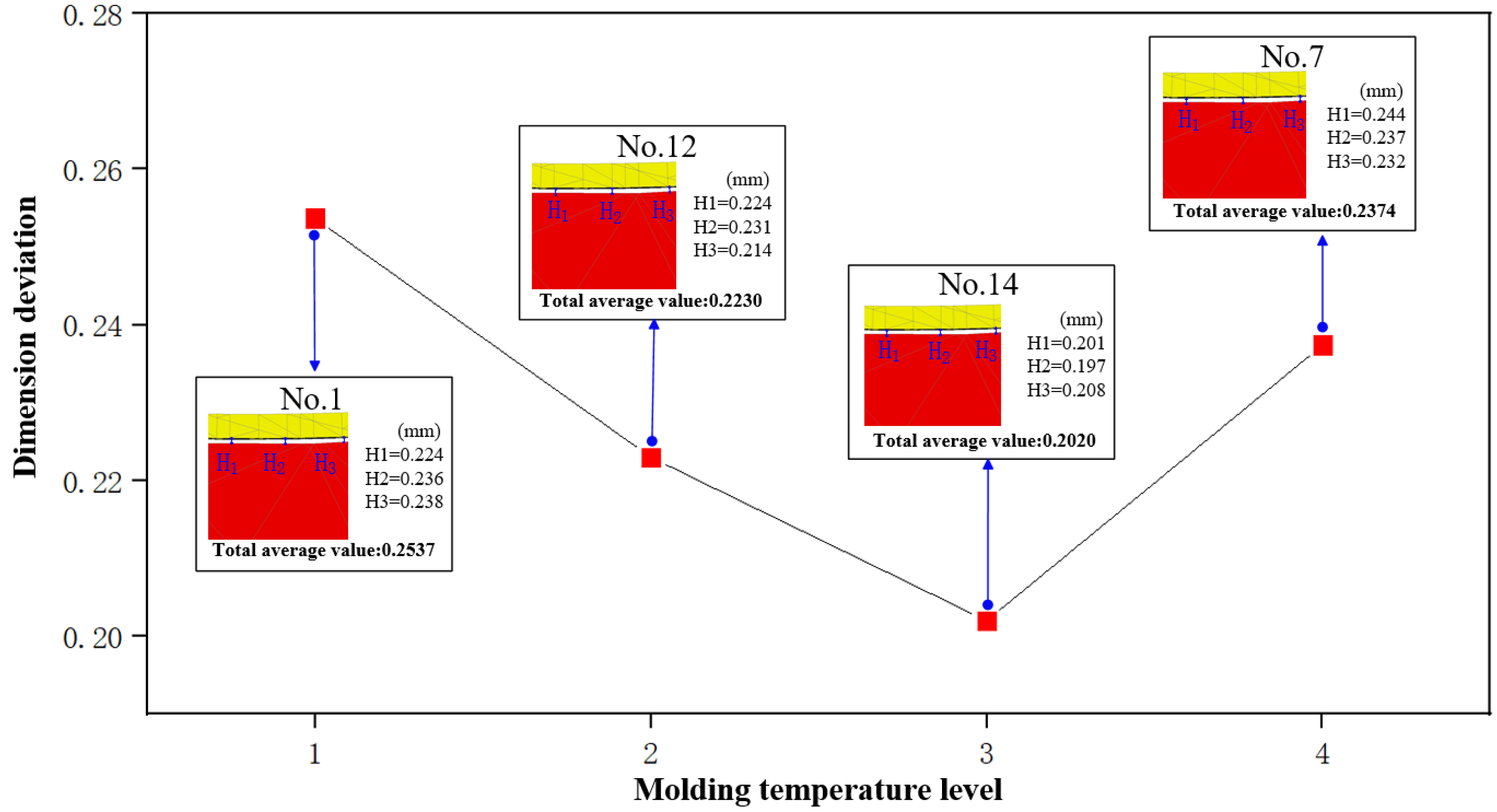

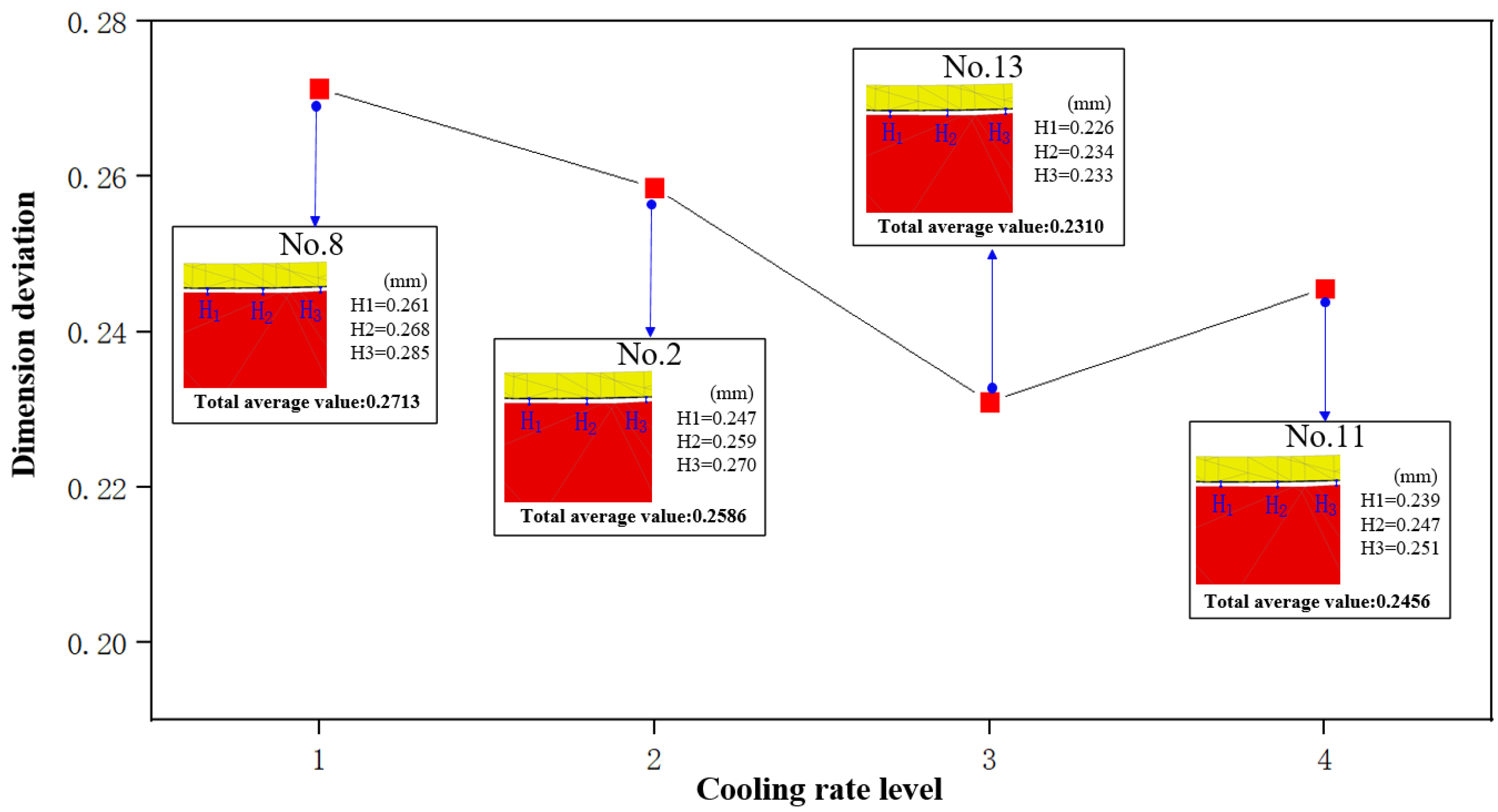
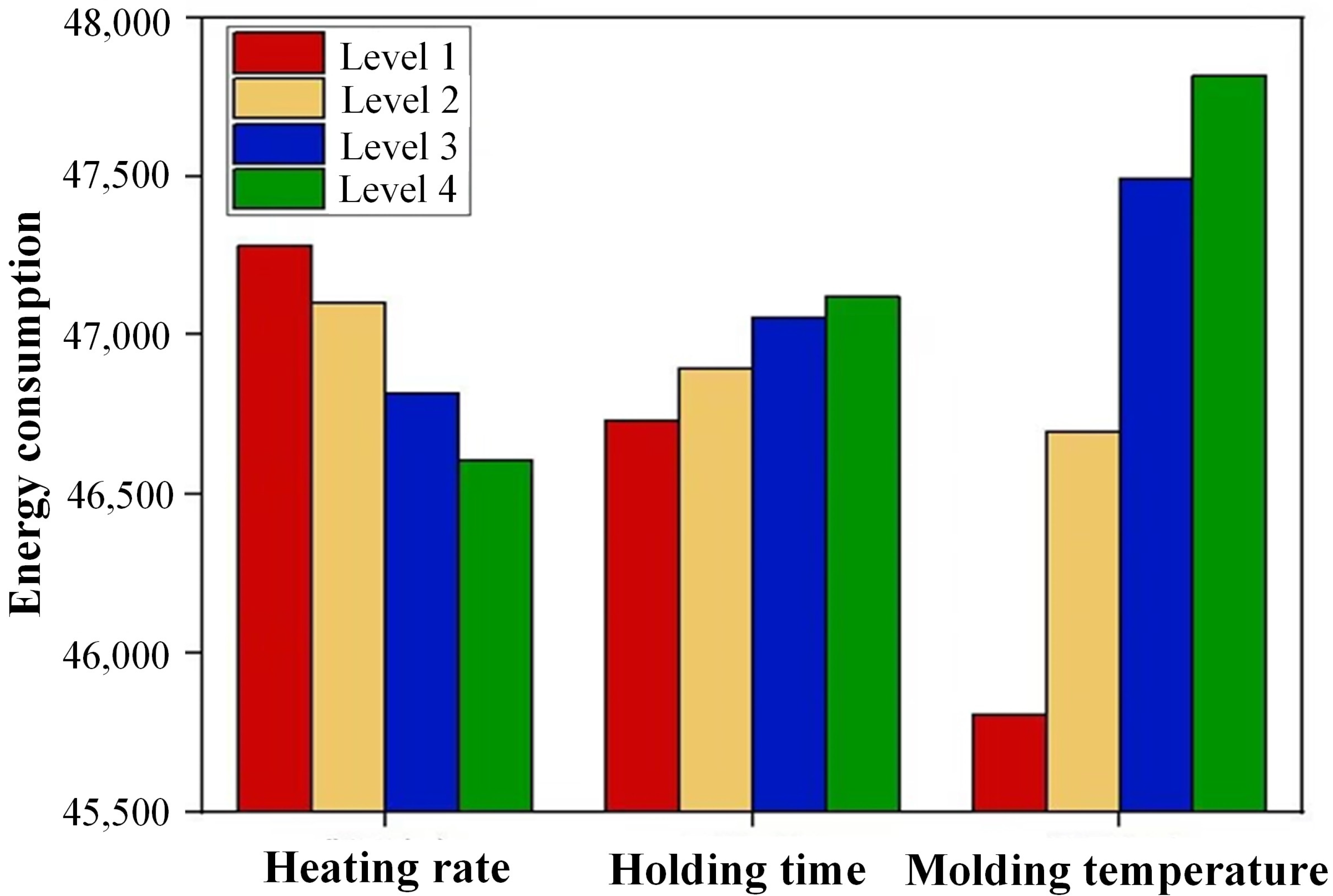
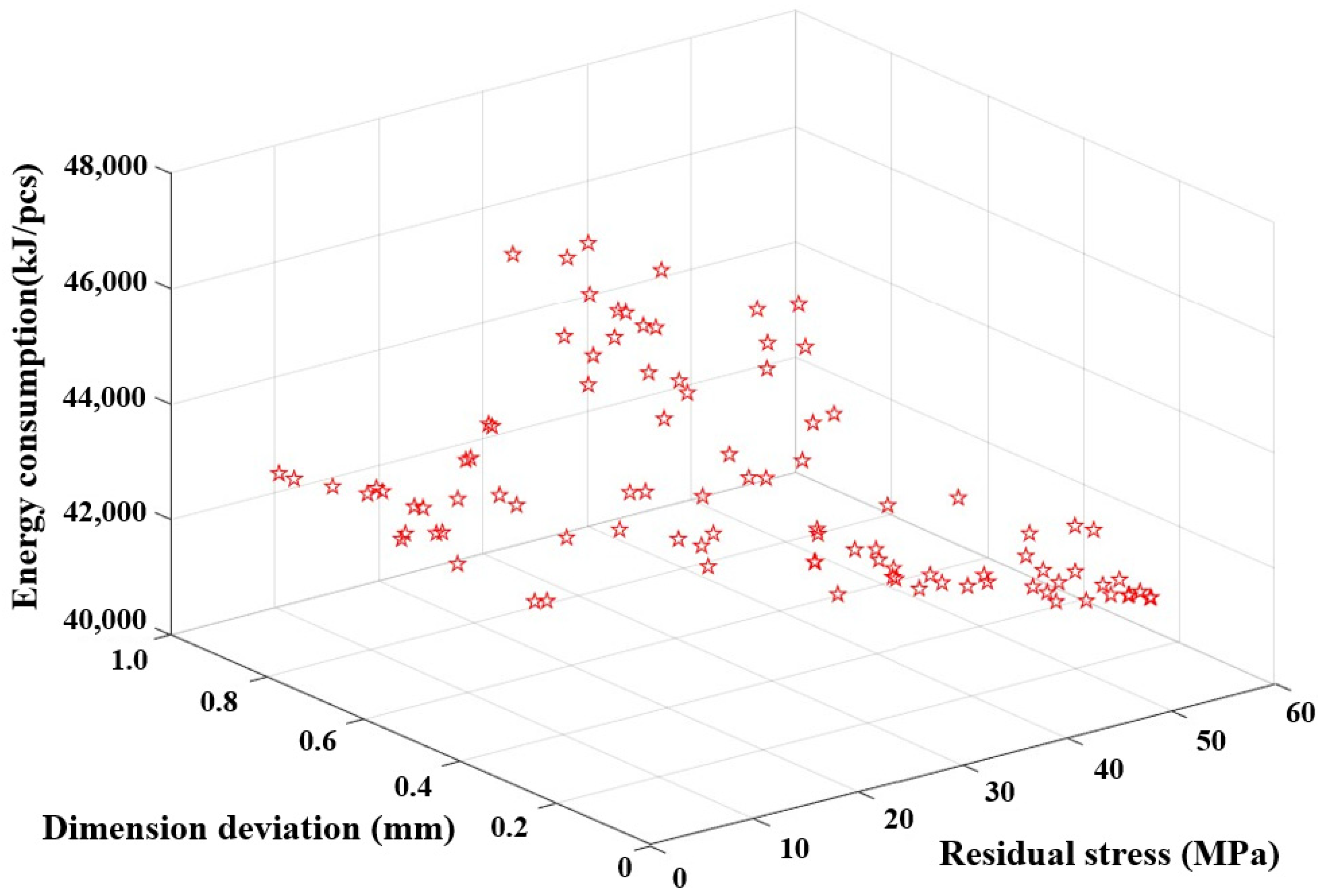
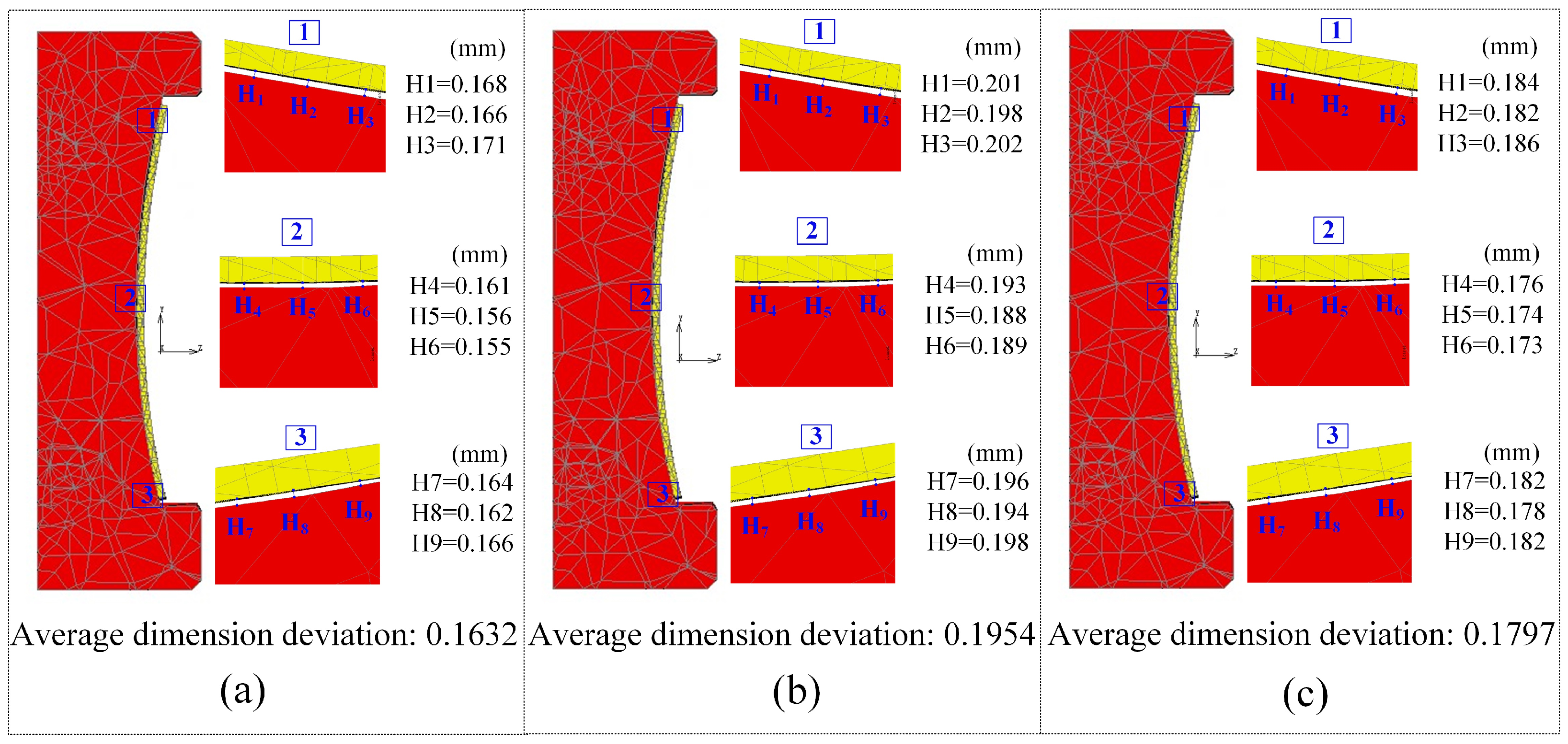
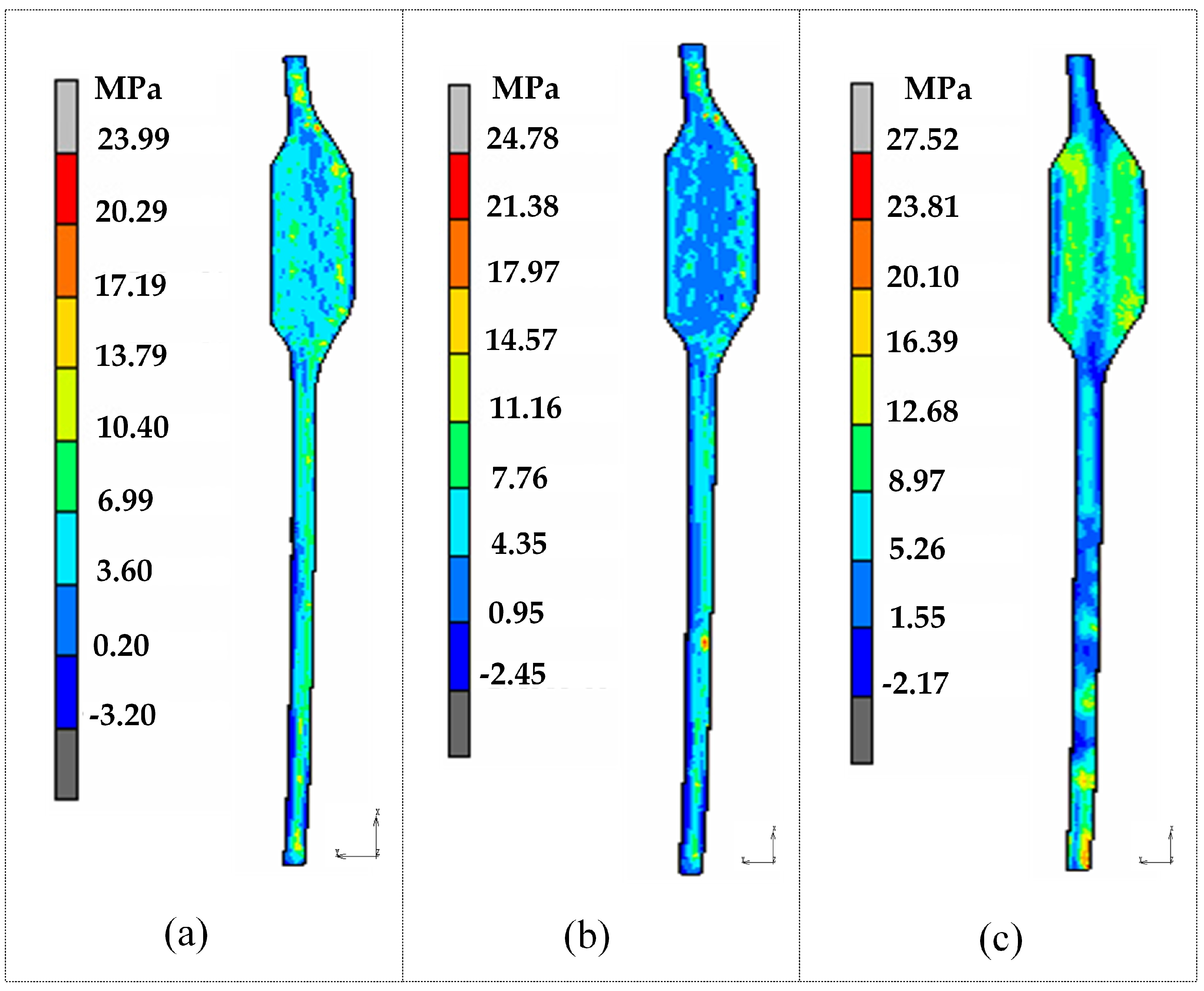
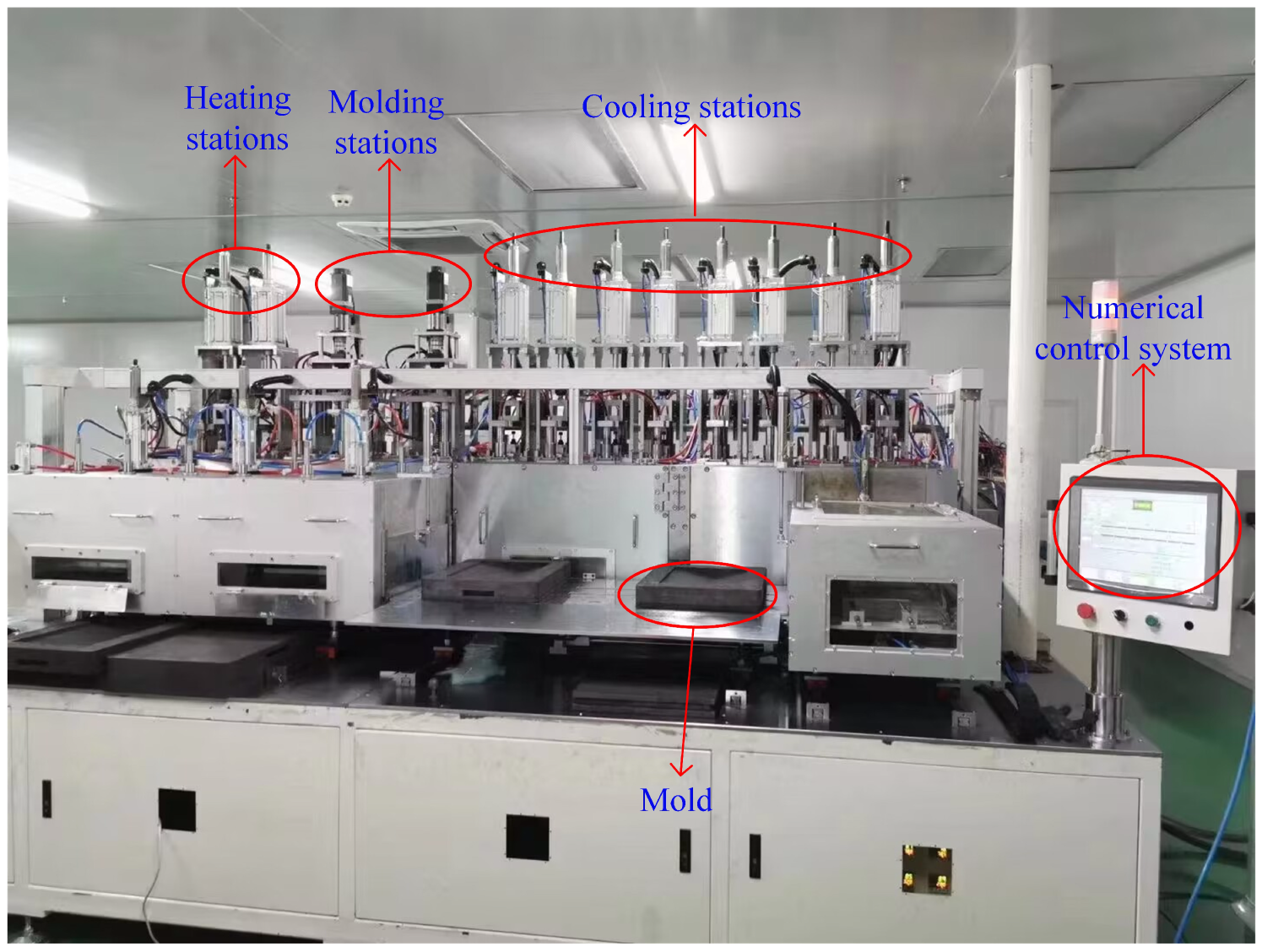
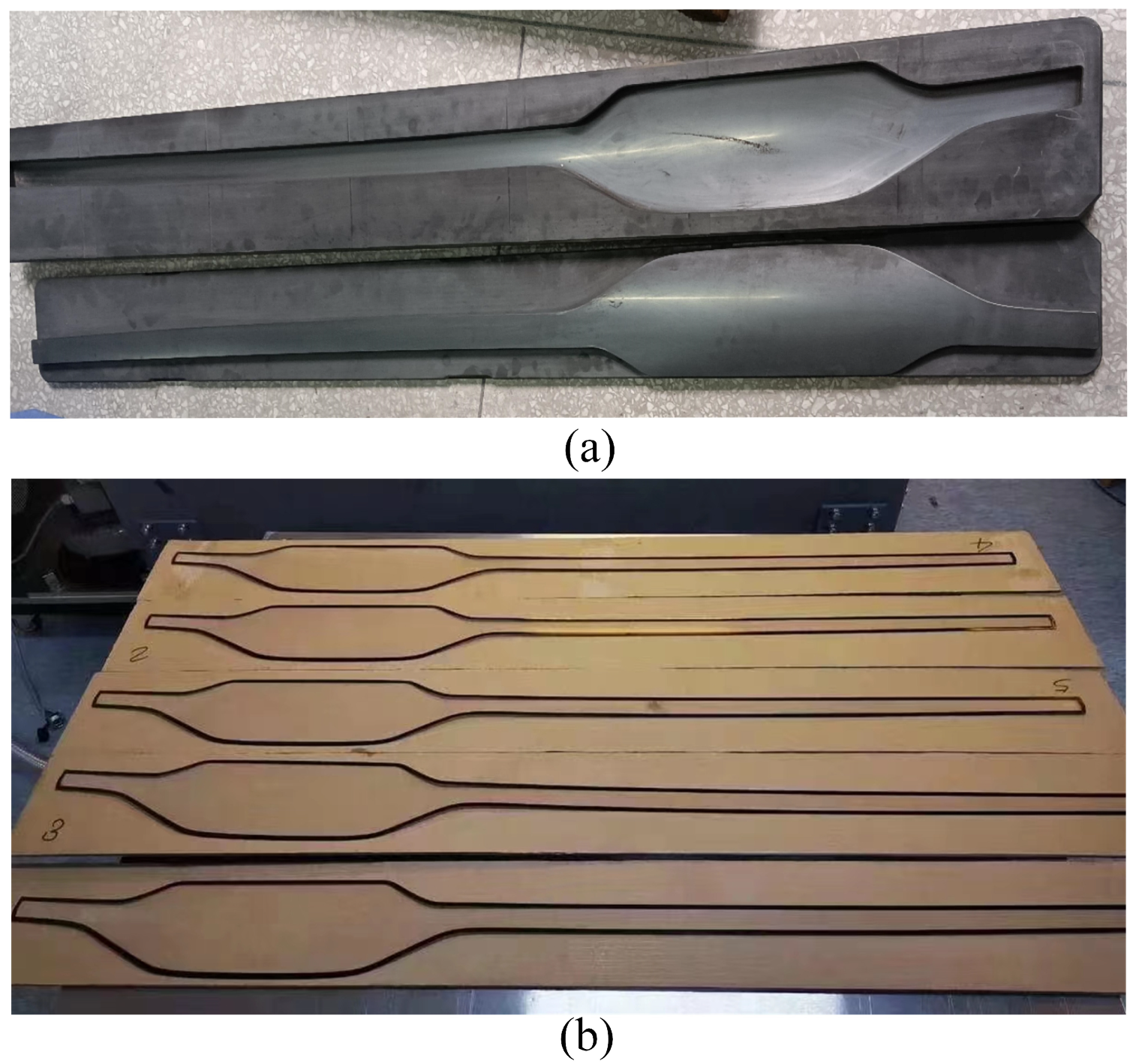
| Glass Components | Dimension | Aspect Ratio | Irregular |
|---|---|---|---|
| Vehicle glass component | 1454 × 161 × 2 mm | 9.03 | Yes |
| Smartphone 3D curved screen [27] | 148 × 73 × 0.35 mm | 2.03 | No |
| Fingerprint lock glass panel [30] | 348 × 66.6 × 2 mm | 5.23 | No |
| Mobile display obtuse glass component [31] | Φ = 14 mm; h = 7 mm | 1 | No |
| Alvarez lens [32] | Φ = 84 mm; h = 1 mm | 1 | Yes |
| Aspherical glass component [33] | 13 × 3.5 × 1 mm | 3.71 | No |
| Properties | Glass Material | Mold Material |
|---|---|---|
| Density ρ (g/cm3) | 2.39 | 1.78 |
| Young’s modulus E (GPa) | 77 | 10.2 |
| Poisson rate ν | 0.22 | 0.25 |
| Thermal conductivity K (W/m·°C) | 1.028 | 151 |
| Specific heat Cp (J/kg·°C) | 858 | 720 |
| Thermal expansion coefficient (/°C) | 7.25 × 10−6 | 4.8 × 10−6 |
| No. | Temperature (°C) | Viscosity |
|---|---|---|
| 1 | 574 | 1014.7 |
| 2 | 628 | 1013.2 |
| 3 | 900 | 107.60 |
| No. | Control Factors | ||||
|---|---|---|---|---|---|
| A (°C) | B (°C/s) | C (s) | D (MPa) | E (°C/s) | |
| 1 | 1.5 | 100 | 550 | 20 | 0.75 |
| 2 | 2.0 | 120 | 560 | 25 | 1 |
| 3 | 2.5 | 140 | 570 | 30 | 1.25 |
| 4 | 3.0 | 160 | 580 | 35 | 1.5 |
| No. | Control Factors | Residual Stress (MPa) | Dimension Deviation (mm) | Energy Consumption (kJ/pcs) | ||||
|---|---|---|---|---|---|---|---|---|
| A | B | C | D | E | ||||
| 1 | 1.5 | 100 | 550 | 20 | 0.75 | 28.98 | 0.2537 | 45,921.5 |
| 2 | 1.5 | 120 | 560 | 25 | 1 | 23.16 | 0.2586 | 46,942.6 |
| 3 | 1.5 | 140 | 570 | 30 | 1.25 | 19.92 | 0.1851 | 47,937.1 |
| 4 | 1.5 | 160 | 580 | 35 | 1.5 | 18.69 | 0.2307 | 48,328.3 |
| 5 | 2 | 100 | 560 | 30 | 1.5 | 24.87 | 0.1913 | 46,573.2 |
| 6 | 2 | 120 | 550 | 35 | 1.25 | 26.78 | 0.2014 | 45,977.2 |
| 7 | 2 | 140 | 580 | 20 | 1 | 16.69 | 0.2374 | 47,981.6 |
| 8 | 2 | 160 | 570 | 25 | 0.75 | 19.07 | 0.2713 | 47,879.3 |
| 9 | 2.5 | 100 | 570 | 35 | 1 | 20.07 | 0.1928 | 47,113.4 |
| 10 | 2.5 | 120 | 580 | 30 | 0.75 | 17.97 | 0.2377 | 47,631.1 |
| 11 | 2.5 | 140 | 550 | 25 | 1.5 | 30.06 | 0.2456 | 45,777.9 |
| 12 | 2.5 | 160 | 560 | 20 | 1.25 | 22.32 | 0.2230 | 46,737.3 |
| 13 | 3 | 100 | 580 | 25 | 1.25 | 17.55 | 0.2310 | 47,318.8 |
| 14 | 3 | 120 | 570 | 20 | 1.5 | 18.72 | 0.2020 | 47,032.3 |
| 15 | 3 | 140 | 560 | 35 | 0.75 | 26.16 | 0.2210 | 46,524.7 |
| 16 | 3 | 160 | 550 | 30 | 1 | 31.27 | 0.2053 | 45,539.2 |
| Level | A | B | C | D | E |
|---|---|---|---|---|---|
| 1 | 22.69 | 22.87 | 31.02 | 21.28 | 23.04 |
| 2 | 23.21 | 23.41 | 24.13 | 22.46 | 22.40 |
| 3 | 22.60 | 22.81 | 19.45 | 23.51 | 23.39 |
| 4 | 23.42 | 22.84 | 17.33 | 24.68 | 23.09 |
| Delta | 0.82 | 0.60 | 13.70 | 3.40 | 1.00 |
| Order | 4 | 5 | 1 | 2 | 3 |
| Level | A | B | C | D | E |
|---|---|---|---|---|---|
| 1 | 0.2320 | 0.2172 | 0.2265 | 0.2290 | 0.2459 |
| 2 | 0.2253 | 0.2249 | 0.2235 | 0.2516 | 0.2235 |
| 3 | 0.2248 | 0.2223 | 0.2128 | 0.2049 | 0.2101 |
| 4 | 0.2148 | 0.2326 | 0.2342 | 0.2115 | 0.2174 |
| Delta | 0.0172 | 0.0154 | 0.0214 | 0.0468 | 0.0358 |
| Order | 4 | 5 | 3 | 1 | 2 |
| Level | A | B | C | D | E |
|---|---|---|---|---|---|
| 1 | 47,282 | 46,732 | 45,804 | 46,918 | 46,989 |
| 2 | 47,103 | 46,896 | 46,694 | 46,980 | 46,894 |
| 3 | 46,815 | 47,055 | 47,491 | 46,920 | 46,993 |
| 4 | 46,604 | 47,121 | 47,815 | 46,986 | 46,928 |
| Delta | 679 | 389 | 2011 | 68 | 98 |
| Order | 2 | 3 | 1 | 5 | 4 |
| No. | Control Factors | Residual Stress (MPa) | Dimension Deviation (mm) | Energy Consumption (kJ/pcs) | ||||
|---|---|---|---|---|---|---|---|---|
| A | B | C | D | E | ||||
| 1 | 1.873 | 158.34 | 572.47 | 33.861 | 1.239 | 19.71 | 0.1903 | 44,770 |
| 2 | 1.906 | 158.41 | 567.47 | 34.365 | 1.034 | 20.60 | 0.1966 | 45,280 |
| 3 | 1.997 | 158.30 | 574.55 | 34.144 | 1.147 | 21.04 | 0.1772 | 44,920 |
| 4 | 1.844 | 154.18 | 566.93 | 34.650 | 1.109 | 22.73 | 0.1863 | 44,240 |
| 5 | 2.069 | 159.26 | 571.12 | 34.959 | 1.139 | 23.04 | 0.1862 | 45,180 |
| 6 | 2.108 | 158.34 | 573.75 | 34.729 | 1.181 | 23.48 | 0.1868 | 44,800 |
| 7 | 1.918 | 157.04 | 567.47 | 34.512 | 1.068 | 23.80 | 0.1832 | 45,600 |
| 8 | 2.125 | 158.54 | 572.31 | 34.811 | 1.252 | 24.21 | 0.1832 | 44,590 |
| No. | Control Factors | Simulation Results | Relative Error | ||||||||
|---|---|---|---|---|---|---|---|---|---|---|---|
| A (°C/s) | B (s) | C (°C) | D (MPa) | E (°C/s) | Rs (MPa) | Sd (mm) | Ee (kJ/pcs) | Rs (%) | Sd (%) | Ee (%) | |
| 3 | 1.997 | 158.30 | 574.55 | 34.144 | 1.147 | 23.99 | 0.1632 | 46,270.3 | 12.3 | 8.6 | 2.9 |
| 4 | 1.844 | 154.18 | 566.93 | 34.650 | 1.109 | 24.78 | 0.1954 | 47,951.2 | 8.3 | 4.7 | 7.7 |
| 5 | 2.069 | 149.26 | 571.12 | 34.959 | 1.139 | 27.52 | 0.1797 | 48,651.2 | 16.3 | 3.6 | 7.1 |
Disclaimer/Publisher’s Note: The statements, opinions and data contained in all publications are solely those of the individual author(s) and contributor(s) and not of MDPI and/or the editor(s). MDPI and/or the editor(s) disclaim responsibility for any injury to people or property resulting from any ideas, methods, instructions or products referred to in the content. |
© 2023 by the authors. Licensee MDPI, Basel, Switzerland. This article is an open access article distributed under the terms and conditions of the Creative Commons Attribution (CC BY) license (https://creativecommons.org/licenses/by/4.0/).
Share and Cite
Chen, Z.; Hu, S.; Zhang, S.; Zhang, Q.; Zhang, Z.; Ming, W. Simulation and Experimental Study on the Precision Molding of Irregular Vehicle Glass Components. Micromachines 2023, 14, 1974. https://doi.org/10.3390/mi14101974
Chen Z, Hu S, Zhang S, Zhang Q, Zhang Z, Ming W. Simulation and Experimental Study on the Precision Molding of Irregular Vehicle Glass Components. Micromachines. 2023; 14(10):1974. https://doi.org/10.3390/mi14101974
Chicago/Turabian StyleChen, Zhijun, Shunchang Hu, Shengfei Zhang, Qingdong Zhang, Zhen Zhang, and Wuyi Ming. 2023. "Simulation and Experimental Study on the Precision Molding of Irregular Vehicle Glass Components" Micromachines 14, no. 10: 1974. https://doi.org/10.3390/mi14101974






